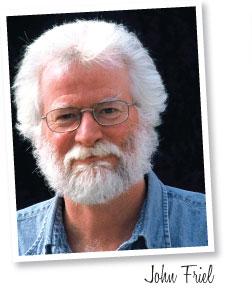6/1/2023
Deja View
John Friel

The brilliant Annie Dillard wrote, “Spring is seeping north, toward me and away from me, at 16 miles a day.”
Yes, I’ve used that quote before. It’s worth recycling. I tested Annie’s math recently by driving, not seeping, north—i.e., back in time—for a canoe trip through a gorgeous gorge, the Pennsylvania Grand Canyon. If tucked into the real Grand Canyon, PA’s version would be just one of many side streams. But it would be the prettiest.
This kind of time travel needs no flux capacitor-equipped DeLorean. A Honda will do. (I had a DeLorean once, but I only drove it from time to time.) Memories are also a fine vehicle to the past: I’ve been making this trip, with few exceptions, since the late 1980s. Memories galore.
From near Maryland almost to New York is about 125 miles. By the Dillard principle, that’s just eight days. Some years, it’s felt like a month. Distance from the poles is the ironclad determinant of seasons, but there’s wiggle room. Another strong factor besides latitude: altitude. It’s no coincidence that they’re anagrams.
This trek involves a gain of over 1,000 feet and the loss of a full USDA hardiness zone. I’ve grown accustomed to leaving lush green lawns, spent daffodils and trees bursting with blossoms.
As miles ticked off, the scene would change: Late spring in the rear-view, early spring/late winter spread out ahead. Lawns were patchy brown, trees just beginning to bud. The warm breezes of home were a distant memory as we’d beach our boats and pitch camp streamside the next night. Sometimes a leftover snowdrift, slushy, crunchy, big as a Buick, lurked behind our tents.
It’s mostly flora that marks seasonal change, but some fauna also help—like a favorite waterbird, the common merganser. These sleek divers appear in the river behind my house in February and stay into April. When I go north in May, there they are, with babies.
This year’s mild winter blurred the lines. Daffodils were still in their prime, but overall the northern tier didn’t differ drastically from home. The tree canopy was leafier than usual. Lawns had obviously been mowed already.
Bowing to lousy weather, nursing a sore knee, I skipped paddling this year. After seeing off a few hardier souls, I visited a local IGC, Martin’s Landscape Service and Garden Center.
Grower/propagator Jody Applebee showed me around. A graduate of Alfred State College of Technology, part of the SUNY system, he owned his own nursery before coming to Martin’s, whose 3 acres offer a full range of landscape services and supplies like mulch, decorative stone and pavers.
He was surprised I hadn’t heard of Alfred. After looking it up, so am I. This large institution boasts a well-known Ag program encompassing everything from organic/sustainable farming to tropical plant propagation to meat goats.
Relying on unheated greenhouses, closed until April 1, Martin’s buys in most stock. Some perennials, and many trees, are overwintered. Fruit trees are a specialty, including $300 apple trees that produce the year they’re planted. “Some people really want to pick an apple,” Jody smiled.
Just two other cars graced the parking lot on the chilly, overcast day of my visit. Rain was expected each of the next five chilly, overcast days—hardly inspirational for boating or gardening. Familiar names adorned the well-grown perennials on the benches: Quality Greenhouses, a large wholesaler downstate that lives up to its name, and the ubiquitous Proven Winners white pots.
Martin’s experienced all facets of the mixed curse of COVID-19. The labor pool shrank; business ballooned. Traditionally, Jody said, a large early shipment of trees would last the whole season with fall sale prices to clear out the stragglers. The last two years that load sold out by Mother’s Day, with a refill by Memorial Day.
I told Jody the pandemic spawned an estimated 16 million new gardeners. “Not surprised,” he replied. “People were home, people had money and everybody wanted a garden. And we had to educate them.”
Next year, I’ll time-travel north again. If there’s more water in the creek and less in the sky, I’ll paddle. A taste of the past is definitely in my future. GP